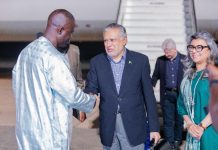ISLAMABAD Aug. 10 (TNS): September 1 is expected to be the first day of Eid al-Adha, but will be confirmed after moon sighting on August 21.
The first day of the Eid al-Adha Muslim festival is expected to be either on Thursday, August 31 or Friday, September 1, 2017.
In the Islamic calendar, Eid al-Adha begins on the 10th day of the Dhu al-Hijjah lunar month; the actual date for Eid will be confirmed after moon sighting on Monday, August 21, the 29th day of the previous lunar month.
If the moon is seen on Monday, Eid al-Adha will be 10 days later on August 31. Otherwise, the lunar month carries on to 30 days, and Eid al-Adha will be celebrated on September 1.
Saudi Arabia’s Um al-Qura calendar marks Eid al-Adha 2017 on September 1, but the official date is announced by the High Judicial Court after the moon sighting. The Hajj pilgrimage to Mecca, which begins two days before Eid al-Adha, is also confirmed then.
Muslim communities in Europe, the United States and Canada follow Saudi Arabia’s Eid announcement, as per the European Council for Fatwa and Research, the Islamic Society of North America (ISNA), and the Fiqh Council of North America.
Bangladesh, Pakistan and India only accept local moon sighting with the naked eye to determine the lunar months’ start and thus follow their local calendar.
At the International Hijri Calendar Unity Congress held in Istanbul in May 2016, members of the Organisation of Islamic Cooperation voted in favour of adopting a unified lunar calendar.
Astronomers calculated the Dhu al-Hijjah new moon birth to be on Monday, August 21 at 18:30 GMT, but have also predicted that it will not be visible to the naked eye and that in Muslim-majority countries the moon will set before sunset.
Traditionally, visibility of the moon crescent depends on the sighting location and meteorological conditions. Recently, it has also depended on the imaging technology used to sight the new moon.
Steve Bell at the UK Hydrographic Office told Al Jazeera that specialist infrared digital cameras could photograph the new moon, which is invisible to telescopes due to their limited optical range. Such sophisticated digital imaging technology has been used in the moon sighting of Eid al-Fitr 2017.
Eid al-Adha is Islam’s holiest festival celebrated annually around the world and is an official holiday in Muslim-majority countries, and in the Philippines. Schools in New York also closed for Eid al-Adha and Eid al-Fitr.
Eid al-Adha in Arabic literally means “festival of the sacrifice”, and for Muslims it commemorates the day when Prophet Abraham intended to sacrifice his son but was instructed by God to offer an animal instead.
Eid al-Adha is locally also known as: Eidul Adha, as spelled in the Philippines legislation. Eid el-Kabir, as commonly referred to in Nigeria and Morocco. Tabaski, as referred to in Senegal and Gambia. Kurban Bayrami, as referred to in Turkey. Hari Raya Haji, as known in Indonesia, Malaysia and Singapore. Bakr-Id or Qurbani Eid , as referred to in the Urdu langauge, in India and in Bangladesh.
In 2016, Eid al-Adha was expected to begin on September 11. But having not sighted the moon on September 1, the High Judicial Court in Saudi Arabia announced on September 2 that Eid will instead be on September 12.
Bangladesh, India and Pakistan celebrated Eid on September 13. According to the Central Ruet-e-Hilal Committee in Pakistan, the first day of the Dhu al-Hijjah lunar month was September 4, whereas for Saudi Arabia it was on September 3.
Traditionally, the Eid al-Adha festival lasts for four days but public holidays vary from country to country.













